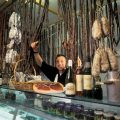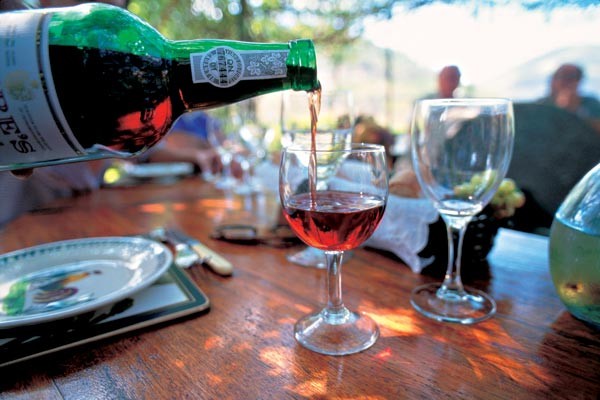 Portuguese port wineIt happened in the middle17th century, when England imposed a ban on the import of Bordeaux wines from hostile France. Portuguese winemakers decided to take advantage of this circumstance by increasing exports to Britain. To prevent the wine, which was not sufficiently aged or immature, which was a common vice of European wines of that time, from going sour during transportation by sea, a certain amount of alcohol was sometimes added to it. However, there is another version, which ties the birth of port wine to a specific place - the town of Lamego - and, of course, as is customary in the history of wine, to a certain clergyman - the abbot of the local monastery. According to legend, it was he who in 1678 treated two Liverpool wine merchants to a very pleasant, sweetish and unusually harmonious wine, which they rated as the best of all they had tasted in the Douro Valley. The abbot's secret was simple: he added cognac spirit to the wine during fermentation. And it must be assumed that the abbot of Lamego was not the only one who knew this secret. However, for some reason history has brought us precisely this episode. So we have no choice but to imagine two young gentlemen in jackboots, embroidered waistcoats with ruffs, who, in joyful excitement, descend the endless flights of stairs broken on the hill where the monastery stands.
Portuguese port wineIt happened in the middle17th century, when England imposed a ban on the import of Bordeaux wines from hostile France. Portuguese winemakers decided to take advantage of this circumstance by increasing exports to Britain. To prevent the wine, which was not sufficiently aged or immature, which was a common vice of European wines of that time, from going sour during transportation by sea, a certain amount of alcohol was sometimes added to it. However, there is another version, which ties the birth of port wine to a specific place - the town of Lamego - and, of course, as is customary in the history of wine, to a certain clergyman - the abbot of the local monastery. According to legend, it was he who in 1678 treated two Liverpool wine merchants to a very pleasant, sweetish and unusually harmonious wine, which they rated as the best of all they had tasted in the Douro Valley. The abbot's secret was simple: he added cognac spirit to the wine during fermentation. And it must be assumed that the abbot of Lamego was not the only one who knew this secret. However, for some reason history has brought us precisely this episode. So we have no choice but to imagine two young gentlemen in jackboots, embroidered waistcoats with ruffs, who, in joyful excitement, descend the endless flights of stairs broken on the hill where the monastery stands.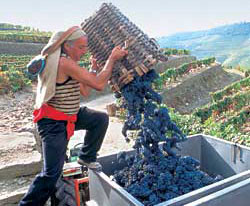 For all its beauty, Lamego is not the mosta typical place for the Douro Valley, as it is located quite far from the river. And yet the valley and the river require a separate description. At the beginning of its journey, in Spain, this river bears the famous name of Duero and flows through three famous wine regions - Ribera del Duero, Rueda and Toro. In its middle reaches, becoming the Portuguese Douro, it acquires a truly epic scope and slowly rolls between cozy green slopes, in the rocky slate of which vineyards are laid out. The birth of port wineThe merchants who visited Lamego (and eventually sent a large batch of wine from there to their homeland) were not at all pioneers in the Portuguese wine market. Half a century before, the German merchant Kopke had been trading in local wines, and in the 19th century, an English company called Warre's also settled in the Douro Valley, and to this day it produces its ports (Warres) under this name. However, at that time, of course, there was no talk of producing port. In the Douro Valley, they made (and still make) simply good, dense red wine from varieties of the Touriga grape. Only gradually, at the beginning of the 18th century, seeing that the English particularly liked the stronger version of these wines, they switched to the technology, the author of which is considered to be the abbot of Lamego. The so-called cognac spirit, which was mentioned earlier, has nothing to do with cognac - in fact, it is pure grape vodka, aguardente (fire water), with a strength of 77 degrees. The classic proportion, as determined by local winemakers, is as follows: 1 liter of Aguardente to 4 liters of wine (Aguardente is added during fermentation). Of course, each winemaker can vary this proportion slightly to obtain different results. Another "golden rule", which has developed over several centuries of port history, is that grape alcohol should be added when half of the sugar in the grape juice has been used up (converted into alcohol). However, every good winemaker will implement this truism creatively, depending on how saturated with sugar the fermenting juice is. In the middle reaches of the Douro, between the towns of Regua and São João da Pesqueira, the birthplace of port wine, this drink is only taking its first steps in life. When fermentation is complete, the port wine sets off on its first 75-kilometer journey - to the mouth of the Douro River, to the city of Porto, where it matures and grows up, preparing for longer sea cruises.
For all its beauty, Lamego is not the mosta typical place for the Douro Valley, as it is located quite far from the river. And yet the valley and the river require a separate description. At the beginning of its journey, in Spain, this river bears the famous name of Duero and flows through three famous wine regions - Ribera del Duero, Rueda and Toro. In its middle reaches, becoming the Portuguese Douro, it acquires a truly epic scope and slowly rolls between cozy green slopes, in the rocky slate of which vineyards are laid out. The birth of port wineThe merchants who visited Lamego (and eventually sent a large batch of wine from there to their homeland) were not at all pioneers in the Portuguese wine market. Half a century before, the German merchant Kopke had been trading in local wines, and in the 19th century, an English company called Warre's also settled in the Douro Valley, and to this day it produces its ports (Warres) under this name. However, at that time, of course, there was no talk of producing port. In the Douro Valley, they made (and still make) simply good, dense red wine from varieties of the Touriga grape. Only gradually, at the beginning of the 18th century, seeing that the English particularly liked the stronger version of these wines, they switched to the technology, the author of which is considered to be the abbot of Lamego. The so-called cognac spirit, which was mentioned earlier, has nothing to do with cognac - in fact, it is pure grape vodka, aguardente (fire water), with a strength of 77 degrees. The classic proportion, as determined by local winemakers, is as follows: 1 liter of Aguardente to 4 liters of wine (Aguardente is added during fermentation). Of course, each winemaker can vary this proportion slightly to obtain different results. Another "golden rule", which has developed over several centuries of port history, is that grape alcohol should be added when half of the sugar in the grape juice has been used up (converted into alcohol). However, every good winemaker will implement this truism creatively, depending on how saturated with sugar the fermenting juice is. In the middle reaches of the Douro, between the towns of Regua and São João da Pesqueira, the birthplace of port wine, this drink is only taking its first steps in life. When fermentation is complete, the port wine sets off on its first 75-kilometer journey - to the mouth of the Douro River, to the city of Porto, where it matures and grows up, preparing for longer sea cruises.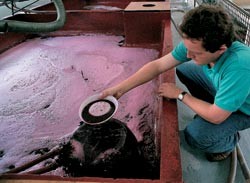 Port outside the valleyпортвейн за пределами долины Дору, на другой почве, в других климатических условиях предпринимались многими виноделами. Ведь с прагматической точки зрения портвейн — это лишь определенная технология, и ее, как и в случае с шампанским, запросто можно применить где угодно. Можно даже попытаться использовать те же сорта винограда, хотя для портвейна это значительно сложнее, чем для шампанского: скажем, турига насьональ, основной для портвейна сорт, географически распространен не так, как базовые сорта шампанского — шардоне и пино нуар. В Южной Африке делать вино в стиле португальского оригинала начали еще в XVIII веке— «Констанция» (Vin de Constance) из Капской провинции некоторое время даже составляла успешную конкуренцию портвейну на европейском рынке. А в Крыму вино под названием «портвейн» как появилось в веке XIX, так до сих пор и изготовляется. Очень любил его Николай II: во время его правления производство этого напитка в Российской империи заметно возросло. Однако революция 1917 года внесла в процесс изготовления нашего портвейна заметные коррективы, в результате которых называться портвейном он в принципе уже не может. Дело в том, что для удешевления продукта в вино на стадии брожения стали добавлять не виноградный, а зерновой спирт. Классифицируют портвейны в СНГ так же, как и все прочие вина, а именно: а) ординарный портвейн (без выдержки в бочках), б) марочный (с выдержкой до трех лет) и в) коллекционный (после выдержки в бочках следует еще и выдержка в бутылках сроком до пяти лет). Из ординарных портвейнов наиболее популярны в прошлые годы были «Агдам» и «777» — белые азербайджанские крепленые вина, которые в массовом объеме разливались (и распивались) и на территории РСФСР — от Дагестана до Питера.Британская традиция, позаимствованная у португальцевК середине XVIII века портвейн вошел в моду, и тон в его производстве задавали англичане. Можно даже сказать, что это южное по своему происхождению вино, как и его испанский собрат херес, стало британским национальным напитком. Во многих английских семьях до сих пор принято в день совершеннолетия юноши откупоривать его ровесницу — бутылку портвейна того же «года урожая». А согласно некоторым историческим легендам, этот напиток оказался и соучастником побед Британской империи: говорят, что накануне Трафальгарской битвы адмирал Нельсон рисовал на столе план предстоящего сражения с наполеоновской армадой пальцем, смоченным в портвейне. Думается, что «чернилами» тут послужил портвейн категории «Руби», но об этом чуть позже. Для удобства хранения и дальнейшей транспортировки вина по океану англичанам понадобились настолько вместительные хранилища, что напротив Порту, на противоположном берегу реки, возник целый пригород — Вила-Нова-ди-Гая. До сих пор полтора десятка британских фирм имеют здесь собственные винные склады, так называемые лоджи. Вывески с их названиями, заманчиво светящиеся по вечерам, видны из центра Порту. Они придают этому красивому старинному городу некий гедонистический колорит. Во время познавательной и опьяняющей прогулки по Вила-Нова-ди-Гая (поскольку при многих лоджах есть и дегустационные залы) на складских стенах можно увидеть отметки уровня воды, сделанные в годы наводнений. Бывало, что бочки с портвейном при таких разливах иногда уплывали из лодж, и у рыбаков, промышляющих в устье Дору, появлялась возможность стать обладателями 550 литров бесплатного портвейна — именно столько вмещает здешняя традиционная винная тара.
Port outside the valleyпортвейн за пределами долины Дору, на другой почве, в других климатических условиях предпринимались многими виноделами. Ведь с прагматической точки зрения портвейн — это лишь определенная технология, и ее, как и в случае с шампанским, запросто можно применить где угодно. Можно даже попытаться использовать те же сорта винограда, хотя для портвейна это значительно сложнее, чем для шампанского: скажем, турига насьональ, основной для портвейна сорт, географически распространен не так, как базовые сорта шампанского — шардоне и пино нуар. В Южной Африке делать вино в стиле португальского оригинала начали еще в XVIII веке— «Констанция» (Vin de Constance) из Капской провинции некоторое время даже составляла успешную конкуренцию портвейну на европейском рынке. А в Крыму вино под названием «портвейн» как появилось в веке XIX, так до сих пор и изготовляется. Очень любил его Николай II: во время его правления производство этого напитка в Российской империи заметно возросло. Однако революция 1917 года внесла в процесс изготовления нашего портвейна заметные коррективы, в результате которых называться портвейном он в принципе уже не может. Дело в том, что для удешевления продукта в вино на стадии брожения стали добавлять не виноградный, а зерновой спирт. Классифицируют портвейны в СНГ так же, как и все прочие вина, а именно: а) ординарный портвейн (без выдержки в бочках), б) марочный (с выдержкой до трех лет) и в) коллекционный (после выдержки в бочках следует еще и выдержка в бутылках сроком до пяти лет). Из ординарных портвейнов наиболее популярны в прошлые годы были «Агдам» и «777» — белые азербайджанские крепленые вина, которые в массовом объеме разливались (и распивались) и на территории РСФСР — от Дагестана до Питера.Британская традиция, позаимствованная у португальцевК середине XVIII века портвейн вошел в моду, и тон в его производстве задавали англичане. Можно даже сказать, что это южное по своему происхождению вино, как и его испанский собрат херес, стало британским национальным напитком. Во многих английских семьях до сих пор принято в день совершеннолетия юноши откупоривать его ровесницу — бутылку портвейна того же «года урожая». А согласно некоторым историческим легендам, этот напиток оказался и соучастником побед Британской империи: говорят, что накануне Трафальгарской битвы адмирал Нельсон рисовал на столе план предстоящего сражения с наполеоновской армадой пальцем, смоченным в портвейне. Думается, что «чернилами» тут послужил портвейн категории «Руби», но об этом чуть позже. Для удобства хранения и дальнейшей транспортировки вина по океану англичанам понадобились настолько вместительные хранилища, что напротив Порту, на противоположном берегу реки, возник целый пригород — Вила-Нова-ди-Гая. До сих пор полтора десятка британских фирм имеют здесь собственные винные склады, так называемые лоджи. Вывески с их названиями, заманчиво светящиеся по вечерам, видны из центра Порту. Они придают этому красивому старинному городу некий гедонистический колорит. Во время познавательной и опьяняющей прогулки по Вила-Нова-ди-Гая (поскольку при многих лоджах есть и дегустационные залы) на складских стенах можно увидеть отметки уровня воды, сделанные в годы наводнений. Бывало, что бочки с портвейном при таких разливах иногда уплывали из лодж, и у рыбаков, промышляющих в устье Дору, появлялась возможность стать обладателями 550 литров бесплатного портвейна — именно столько вмещает здешняя традиционная винная тара.  Although the process of making port wine itselfThe Portuguese had always been in charge of the wine trade, and at first the British merchants controlled the wine trade entirely. However, in 1755 the Marquis of Pombal, the Portuguese Prime Minister, who concentrated almost sole power in his hands and carried out many useful reforms, significantly limited the British monopoly. He created a Trade Commission and founded the Royal Oporto company - as they would say today, a state enterprise for the port trade. A year later, a law was passed that predetermined both the wandering fate and the solid reputation of port wine - a law according to which this wine had to be aged and bottled only in Vila Nova de Gaia. Thus, the doors to the wine market were closed to anyone who could not afford to have their own warehouse in the suburbs of Porto: an undemocratic decision, but a wise one, since the buyer did not have to worry about buying the product of an unreliable and random producer. This law, it must be said, lasted until recently and was changed only in 1986. Now even very small wine estates (called quinta here) from the Douro Valley can enter the port market. A whole "faction" has formed among wine experts who are convinced that port, like any other great wine, should be blended and bottled only in its place of origin. However, most newborn ports still travel to the warehouses of Vila Nova de Gaia in the traditional way. And still the entire Portuguese wine community anathematizes everything that is produced under the name of port outside the Douro region, be it South Africa or Crimea. Gifts of Portugal Portugal is often called a "wine museum", in particular because grapes are still grown and processed here using archaic, "grandfather's" methods. In some farms of the Douro Valley you can even see vines twining around trees, as in ancient times. And the containers in which grapes are crushed with feet, the so-called lagars, are preserved here not only as a tourist attraction: the wine for some ports is actually still "born" in them.
Although the process of making port wine itselfThe Portuguese had always been in charge of the wine trade, and at first the British merchants controlled the wine trade entirely. However, in 1755 the Marquis of Pombal, the Portuguese Prime Minister, who concentrated almost sole power in his hands and carried out many useful reforms, significantly limited the British monopoly. He created a Trade Commission and founded the Royal Oporto company - as they would say today, a state enterprise for the port trade. A year later, a law was passed that predetermined both the wandering fate and the solid reputation of port wine - a law according to which this wine had to be aged and bottled only in Vila Nova de Gaia. Thus, the doors to the wine market were closed to anyone who could not afford to have their own warehouse in the suburbs of Porto: an undemocratic decision, but a wise one, since the buyer did not have to worry about buying the product of an unreliable and random producer. This law, it must be said, lasted until recently and was changed only in 1986. Now even very small wine estates (called quinta here) from the Douro Valley can enter the port market. A whole "faction" has formed among wine experts who are convinced that port, like any other great wine, should be blended and bottled only in its place of origin. However, most newborn ports still travel to the warehouses of Vila Nova de Gaia in the traditional way. And still the entire Portuguese wine community anathematizes everything that is produced under the name of port outside the Douro region, be it South Africa or Crimea. Gifts of Portugal Portugal is often called a "wine museum", in particular because grapes are still grown and processed here using archaic, "grandfather's" methods. In some farms of the Douro Valley you can even see vines twining around trees, as in ancient times. And the containers in which grapes are crushed with feet, the so-called lagars, are preserved here not only as a tourist attraction: the wine for some ports is actually still "born" in them.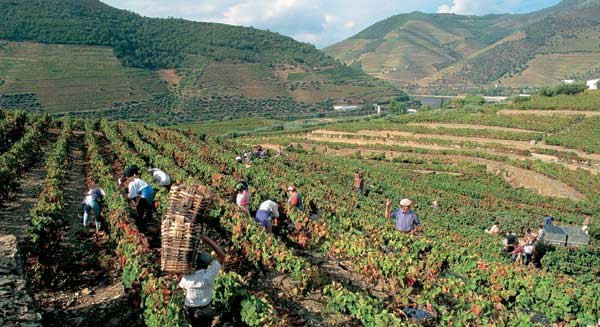 Until the 1980s, Portuguese wines were rarely releasedto the world market. Meanwhile, the potential of local winemaking is enormous, and this has become obvious to all experts since the early 1990s. First of all, the red dry wines from the Douro Valley, as well as from the Dao and Bairrada regions to the south of it, have received recognition. Moreover, while the prices for Douro wines are becoming increasingly higher, those from Bairrada remain noticeably cheaper, while sometimes not inferior in quality. As for white wines, among them, first of all, we must name Vinho Verde, that is, paradoxically, "green". They are truly "green", since they are made from unripe grapes, which gives them a slight effervescence and amazing, bright freshness. The best of these wines are made from Alvarinho grapes in the very north of Portugal. By the way, Vinho Verde also comes in red, dark purple in color, but they are just as fresh in aroma and are drunk, like their white brothers, very chilled. These wines should not be stored for long. To appreciate their youthful energy, it is better to uncork the bottle in the next few months after purchase. Ruby, Tawny and Vintage In Portugal itself, by the way, no one would even think of making port outside the area of its production. Moreover, the quality of each producer's wine is monitored by a special organization, the Porto Wine Institute. It is the institution that determines in which years Vintage port wines can be produced, and in which years winemakers can focus on Ruby and Tawny. Ruby — dark red port with a bright peppery-grape flavor, which is aged in barrels for less than a year. This is the cheapest, so to speak, basic option, which, however, also has its own exquisitely complex version - Fine old ruby, an assemblage, that is, a mixture of ruby ports of different vintages, aged in an oak barrel for two to four years. Tawny matures in a barrel much longer - from 10 to 40 years, becoming much lighter and acquiring a delicate nutty flavor. However, the ideal period for its aging, according to experts, is 20 years. Longer it will become more and more like a liqueur.
Until the 1980s, Portuguese wines were rarely releasedto the world market. Meanwhile, the potential of local winemaking is enormous, and this has become obvious to all experts since the early 1990s. First of all, the red dry wines from the Douro Valley, as well as from the Dao and Bairrada regions to the south of it, have received recognition. Moreover, while the prices for Douro wines are becoming increasingly higher, those from Bairrada remain noticeably cheaper, while sometimes not inferior in quality. As for white wines, among them, first of all, we must name Vinho Verde, that is, paradoxically, "green". They are truly "green", since they are made from unripe grapes, which gives them a slight effervescence and amazing, bright freshness. The best of these wines are made from Alvarinho grapes in the very north of Portugal. By the way, Vinho Verde also comes in red, dark purple in color, but they are just as fresh in aroma and are drunk, like their white brothers, very chilled. These wines should not be stored for long. To appreciate their youthful energy, it is better to uncork the bottle in the next few months after purchase. Ruby, Tawny and Vintage In Portugal itself, by the way, no one would even think of making port outside the area of its production. Moreover, the quality of each producer's wine is monitored by a special organization, the Porto Wine Institute. It is the institution that determines in which years Vintage port wines can be produced, and in which years winemakers can focus on Ruby and Tawny. Ruby — dark red port with a bright peppery-grape flavor, which is aged in barrels for less than a year. This is the cheapest, so to speak, basic option, which, however, also has its own exquisitely complex version - Fine old ruby, an assemblage, that is, a mixture of ruby ports of different vintages, aged in an oak barrel for two to four years. Tawny matures in a barrel much longer - from 10 to 40 years, becoming much lighter and acquiring a delicate nutty flavor. However, the ideal period for its aging, according to experts, is 20 years. Longer it will become more and more like a liqueur.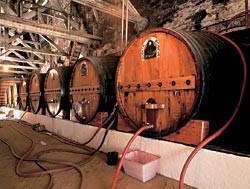 As for « Windiga », then itпроизводят путем смешивания портвейнов, полученных в разные, особенно благоприятные для виноделия годы. Чем-то это напоминает алхимические опыты. Так, портвейн, на этикетке которого значится «Винтидж двадцатилетней давности», разлитый в 2006 году, может вообще не содержать в себе вина урожая 1986 года, но по вкусовым качествам будет соответствовать портвейну двадцатилетней выдержки. Существенное различие в технологии производства «Тони» и «Винтиджа» состоит в том, что последний большую часть жизнь проводит не в бочке, а в бутылке. Как правило, в бутылку он отправляется не позднее, чем через два года выдержки в дубе. Поэтому своим общим вкусовым букетом даже весьма «престарелый» «Винтидж» будет больше похож на «Руби», чем на «Тони»: ведь при выдержке в «недышащем» стекле плодовый вкус вина теряется в гораздо меньшей степени, чем в «дышащей» бочке. Есть две категории «Винтиджа», о которых стоит упомянуть особо. «Винтажный портвейн позднего разлива» («Late bottled vintage»), который, судя по своему названию, должен быть «лучшим из лучших», является на самом деле недорогим компромиссом между «Тони» и «Винтиджем». Делают его хоть и в те годы, которые благоприятны для винтажного портвейна, но из особо «прыткого», готового к раннему созреванию вина, которое затем на шесть лет запирают в бочке. Будучи после этого разлит по бутылкам, он уже фактически готов к употреблению, хотя подержаться в стекле еще пару-тройку лет ему не повредит. А вот действительно лучшие — это винтажные портвейны одного-единственного года урожая, которые иногда бывают еще и сделаны из ягод с одного виноградника (он тоже, как и винодельческие хозяйства, называется quinta). Цена на старые винтажные портвейны бывает далеко не маленькой — ведь это предмет коллекционный, который может неограниченно долго храниться, а затем перепродаваться еще дороже. Скажем, 20-летний винтажный портвейн хорошего производства сейчас стоит от 40 до 100 евро, к которым можно отнестись и как к плате за красивую жизнь, и как к капиталовложению. Ведь лет через 30 стоимость этого вина взлетит в несколько раз! Ну а молодой, «простенький» «Руби» — напиток более чем демократичный, в Европе он может стоить и меньше 10 евро. У нас — 12—15. Чем «закусывать»?Портвейн — вино десертное и, стало быть, как сопровождение к трапезе не годится. Оно — само по себе трапеза, причем наиболее приятная ее часть, и в этом смысле «правы» были многочисленные граждане Советского Союза, распивавшие его без всякой закуски. Возможен — да и то лишь с определенными сортами — только легкий «антураж». Красный портвейн, особенно «Руби», вполне совместим с десертами вроде пирожных. Более изысканные — желательно попивать без всякой еды, чтобы лучше ощутить вкус. (Различить все вкусовые тона — особая работа, при которой и одна рюмка — вполне достаточный материал. Впрочем, слово «рюмка» здесь не совсем уместно. Для портвейна существует свой классический бокал, по форме очень похожий на бокалы для красного вина, только поменьше.) И все же одну, и довольно неожиданную, «закуску» под красный портвейн придумали англичане. Оказалось, что этот напиток превосходно сочетается с сырами с благородной плесенью. Британцы при этом используют свой, вполне определенный сорт сыра — стилтон. Однако его вполне могут заменить и рокфор, и горгонцола. Белый же портвейн пьется сильно охлажденным в самом начале трапезы как аперитив.
As for « Windiga », then itпроизводят путем смешивания портвейнов, полученных в разные, особенно благоприятные для виноделия годы. Чем-то это напоминает алхимические опыты. Так, портвейн, на этикетке которого значится «Винтидж двадцатилетней давности», разлитый в 2006 году, может вообще не содержать в себе вина урожая 1986 года, но по вкусовым качествам будет соответствовать портвейну двадцатилетней выдержки. Существенное различие в технологии производства «Тони» и «Винтиджа» состоит в том, что последний большую часть жизнь проводит не в бочке, а в бутылке. Как правило, в бутылку он отправляется не позднее, чем через два года выдержки в дубе. Поэтому своим общим вкусовым букетом даже весьма «престарелый» «Винтидж» будет больше похож на «Руби», чем на «Тони»: ведь при выдержке в «недышащем» стекле плодовый вкус вина теряется в гораздо меньшей степени, чем в «дышащей» бочке. Есть две категории «Винтиджа», о которых стоит упомянуть особо. «Винтажный портвейн позднего разлива» («Late bottled vintage»), который, судя по своему названию, должен быть «лучшим из лучших», является на самом деле недорогим компромиссом между «Тони» и «Винтиджем». Делают его хоть и в те годы, которые благоприятны для винтажного портвейна, но из особо «прыткого», готового к раннему созреванию вина, которое затем на шесть лет запирают в бочке. Будучи после этого разлит по бутылкам, он уже фактически готов к употреблению, хотя подержаться в стекле еще пару-тройку лет ему не повредит. А вот действительно лучшие — это винтажные портвейны одного-единственного года урожая, которые иногда бывают еще и сделаны из ягод с одного виноградника (он тоже, как и винодельческие хозяйства, называется quinta). Цена на старые винтажные портвейны бывает далеко не маленькой — ведь это предмет коллекционный, который может неограниченно долго храниться, а затем перепродаваться еще дороже. Скажем, 20-летний винтажный портвейн хорошего производства сейчас стоит от 40 до 100 евро, к которым можно отнестись и как к плате за красивую жизнь, и как к капиталовложению. Ведь лет через 30 стоимость этого вина взлетит в несколько раз! Ну а молодой, «простенький» «Руби» — напиток более чем демократичный, в Европе он может стоить и меньше 10 евро. У нас — 12—15. Чем «закусывать»?Портвейн — вино десертное и, стало быть, как сопровождение к трапезе не годится. Оно — само по себе трапеза, причем наиболее приятная ее часть, и в этом смысле «правы» были многочисленные граждане Советского Союза, распивавшие его без всякой закуски. Возможен — да и то лишь с определенными сортами — только легкий «антураж». Красный портвейн, особенно «Руби», вполне совместим с десертами вроде пирожных. Более изысканные — желательно попивать без всякой еды, чтобы лучше ощутить вкус. (Различить все вкусовые тона — особая работа, при которой и одна рюмка — вполне достаточный материал. Впрочем, слово «рюмка» здесь не совсем уместно. Для портвейна существует свой классический бокал, по форме очень похожий на бокалы для красного вина, только поменьше.) И все же одну, и довольно неожиданную, «закуску» под красный портвейн придумали англичане. Оказалось, что этот напиток превосходно сочетается с сырами с благородной плесенью. Британцы при этом используют свой, вполне определенный сорт сыра — стилтон. Однако его вполне могут заменить и рокфор, и горгонцола. Белый же портвейн пьется сильно охлажденным в самом начале трапезы как аперитив.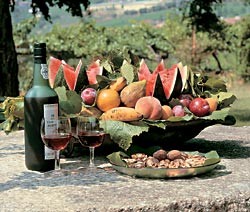 Wine ElitePort wine is not onlytasty, but also beautiful. In the tasting rooms of wineries (in one of which I, like a British youth, but at a much more mature age, had the chance to try the vintage of my year of birth) on white marble slabs, the entire color palette of port wines is specially poured. From pale straw (since there is also white port, it is made from white grapes using the same technology as "Ruby") through golden-fawn and dark "Tony" to ruby- and garnet-red. Nowadays, the production of port is still dominated by British old firms such as Taylor's, Graham's, Dow's, Cockburn's and the already mentioned eternal Warre's (by the way, the firm of the German merchant Kopke has also survived to this day, although it has partially lost its independence). However, since the mid-18th century, Portuguese firms such as Ferreira, Fonseca, and Calem began to join the elite of port wine producers. By the way, experts tend to distinguish between the styles of British and Portuguese producers. Thus, it is believed that the British produce richer, darker and fruitier Ruby's. and "Vintage", but the Portuguese are strong in light and delicate wines, and above all they know how to make wonderful aged "Tony". However, such rules are never without exceptions, and one of the best "Vintage" is now made, for example, by the Champalimaud company. Its owner, Miguel Montes Champalimaud, comes from a family of winemakers known in the Douro Valley since the 13th century. True, he took up the production of port only 20 years ago. Incidentally, it was Miguel who turned out to be a pioneer in the new trend - his most famous port, Quinta do Cotto, is made from berries picked from a single vineyard and is bottled not in Vila Nova de Gaia, but directly at his native winery. Wineries in the Douro Valley, although not so "starred", can in principle be visited by any visitor. Many noble estates here have now been converted into hotels - so-called pousadas. The ancient aristocratic atmosphere, the cozy beauty of the landscape with green slopes and a river winding between the mountains, the silence broken only by the clatter of wheels of the train from Porto passing by the shore - this is exactly what the native places of one of the sweetest, most attractive and soulful drinks in the world look like.
Wine ElitePort wine is not onlytasty, but also beautiful. In the tasting rooms of wineries (in one of which I, like a British youth, but at a much more mature age, had the chance to try the vintage of my year of birth) on white marble slabs, the entire color palette of port wines is specially poured. From pale straw (since there is also white port, it is made from white grapes using the same technology as "Ruby") through golden-fawn and dark "Tony" to ruby- and garnet-red. Nowadays, the production of port is still dominated by British old firms such as Taylor's, Graham's, Dow's, Cockburn's and the already mentioned eternal Warre's (by the way, the firm of the German merchant Kopke has also survived to this day, although it has partially lost its independence). However, since the mid-18th century, Portuguese firms such as Ferreira, Fonseca, and Calem began to join the elite of port wine producers. By the way, experts tend to distinguish between the styles of British and Portuguese producers. Thus, it is believed that the British produce richer, darker and fruitier Ruby's. and "Vintage", but the Portuguese are strong in light and delicate wines, and above all they know how to make wonderful aged "Tony". However, such rules are never without exceptions, and one of the best "Vintage" is now made, for example, by the Champalimaud company. Its owner, Miguel Montes Champalimaud, comes from a family of winemakers known in the Douro Valley since the 13th century. True, he took up the production of port only 20 years ago. Incidentally, it was Miguel who turned out to be a pioneer in the new trend - his most famous port, Quinta do Cotto, is made from berries picked from a single vineyard and is bottled not in Vila Nova de Gaia, but directly at his native winery. Wineries in the Douro Valley, although not so "starred", can in principle be visited by any visitor. Many noble estates here have now been converted into hotels - so-called pousadas. The ancient aristocratic atmosphere, the cozy beauty of the landscape with green slopes and a river winding between the mountains, the silence broken only by the clatter of wheels of the train from Porto passing by the shore - this is exactly what the native places of one of the sweetest, most attractive and soulful drinks in the world look like.

Making Money with Desserts: Success Stories
Evgeniya Polischuk (Fedutinova) instagram:@evgeniyafedutinovavk.com/janeshomebaking– It all started with baking for family and friends. Gradually, I started posting photos of my baked goods on Instagram – and orders started coming in. I made my first custom-made cake on October 13, 2014, and a little earlier I started making macaroons and cupcakes. You could say that the business “found me”, I am very […]

Soups are cold recipes with photos
Cold cucumber soup with yogurt and lemonsorbet from the chef of the restaurant La Taverna Alexander Zhurkin Photo: Getty Images Ingredients: Plain yoghurt – 125 g Cucumber – 150 g Lemon/lime sorbet – 50 g Cocktail shrimp – 24 g Fresh ginger juice – 1 g Lime juice – 5 g Fresh orange juice – 5 g Parsley – 1 g Pink pepper – 1 g Watercress – […]

barbeque kebab
Pork tenderloin in glaze Photo:Dmitry Bayrak/dbstudioPreparation time: 20 minutes + marinating time.Calories: 454 kcal per serving.For 4 servings: 4 pork tenderloins (approximately 300 g each), 1 onion, 2 cloves of garlic, 1 tsp. lemon zest, 1 tsp. lemon juice, a pinch of ground cumin, coriander and turmeric, 1 tbsp. vegetable […]

Pierre Duacan: dietary recipes: Ducane diet
Beetroot soup Photo:Season’S, Luxury Hotels RepresentationYou will need:· Boiled beetroot – 60 g· Fresh cucumbers – 20 g· Red radish – 20 g· Green onions – 10 g· Egg – 1 pc.· Drinking mineral water – 200 g· Salt – 1 gPreparation:· Boil the egg and beetroot.· Grate the cucumbers, radish and part of the beetroot. Put everything […]





